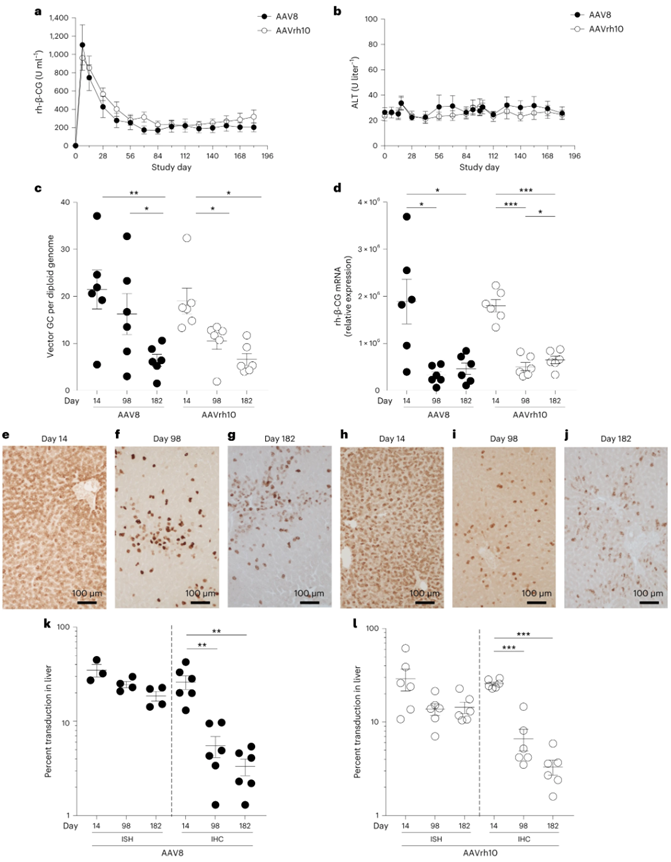Professor James Wilson's team from the University of Pennsylvania published a research paper titled "Integrated vector genomes may contribute to long-term expression in primate liver after AAV administration" in the journal Nature Biotechnology. On the same day, Professor James Wilson's team also published a research paper titled "Prevalent and Disseminated Recombinant and Wild-Type Adeno-Associated Virus Integration in Macaques and Humans" in the journal Human Gene Therapy.
These two studies are the most comprehensive exploration of host genome integration by adeno-associated virus (AAV) in non-human primates to date, and have important implications for the safety and long-term efficacy of AAV gene therapy. This study demonstrates the potential of a liver-targeted AAV to integrate into the host cell genome, providing long-lasting expression without being likely to drive oncogenic mutations.
Previous studies on AAV gene therapy targeting the liver of mice (especially neonatal mice) have found that insertion and integration of the AAV vector genome can cause liver cancer by destroying regulatory elements in the genome that block cancer. But whether this also occurs in humans and other primates is unclear.
In a paper published in the journal Human Gene Therapy, the team examined tissue samples (mainly liver samples) from 86 monkeys that received AAV-based gene therapy in preclinical trials. Tissue samples (mainly liver samples) from 253 monkeys and humans (168 monkeys, 85 humans) who had never been exposed to engineered AAVs were also examined.
The results showed that monkeys who received engineered AAV gene therapy, as well as monkeys and humans who were only exposed to wild-type AAV (the natural AAV that occurs in nature), had a low probability of AAV inserting in a randomly distributed manner throughout the genome. The risk of expansion was also low, even in monkeys 15 years after AAV gene therapy.
In a paper published in the journal Nature Biotechnology, the research team followed 12 monkeys for more than two years who received liver-targeted AAV gene therapy.
Liver-targeting adeno-associated virus (AAV) gene therapy has been approved for the treatment of hemophilia A and hemophilia B, and there are a number of liver-targeting AAV therapies in postclinical development. However, there are two major challenges with liver-targeted AAV gene therapy—one is the persistence of AAV in the liver, and the other is the difficulty in re-administration. Previous clinical studies of AAV gene therapy for hemophilia B have shown that efficacy begins to decline within the first 2 months of treatment. In addition, serum bilirubin in patients with Crigler-Najjar syndrome (a recessive form of hyperbilirubinemia) who receive AAV gene therapy decreases immediately but returns to pre-treatment levels within 2 months. The patients had no significant AAV vector immunity or liver inflammation, suggesting that non-immune mechanisms may be responsible for the loss of efficacy.
However, AAV expression levels remain at a low level in nonhuman primate (NHP) and human livers after a period of expression instability that lasts several months. This is surprising because liver cells are constantly dividing and renewing, and theoretically the free AAV genome should be continuously diluted.
In order to understand the reason, Professor James Wilson intravenously injected AAV8 and AAVrh10 vectors into non-human primates (NHP). Observations and evaluations were conducted over 2 years to better define the mechanisms of AAV transduction that influence gene therapy efficacy.
The results showed that a high degree of transduction of the non-immunogenic transgene was achieved, although expression began to decline within the first 90 days and reached a lower but stable expression state. The mononuclear domain of the AAV vector DNA is still present in more than 10% of hepatocytes, although the expression of the transferred gene may have been lost. Greater reductions in AAV vector DNA and RNA were observed with immunogenic transgenes. In addition, the frequency of AAV vector sequences integrated into the chromosome at different locations in the genome was low, and none of these locations were close to liver cancer-related genes, and there was no evidence of obvious clonal expansion during the follow-up years.

Figure 1. Initial peak followed by a decline to lower stable levels of self-transgene after i.v. administration of AAV vectors to NHPs. (Jenny A. Greig, et al. 2023)
These results indicate that AAV-mediated transgene expression in primate hepatocytes occurs in two phases: first, high-level but short-term expression from the free AAV genome; and then low-level but sustained stable expression. This suggests that persistence of AAV gene therapy in primate livers may be due to integration of AAV vectors.
References
Jenny A. Greig, et al. Integrated vector genomes may contribute to long-term expression in primate liver after AAV administration. Nature Biotechnology, 2023
Kelly M Martins, et al. Prevalent and Disseminated Recombinant and Wild-Type Adeno-Associated Virus Integration in Macaques and Humans. Human Gene Therapy, 2023

